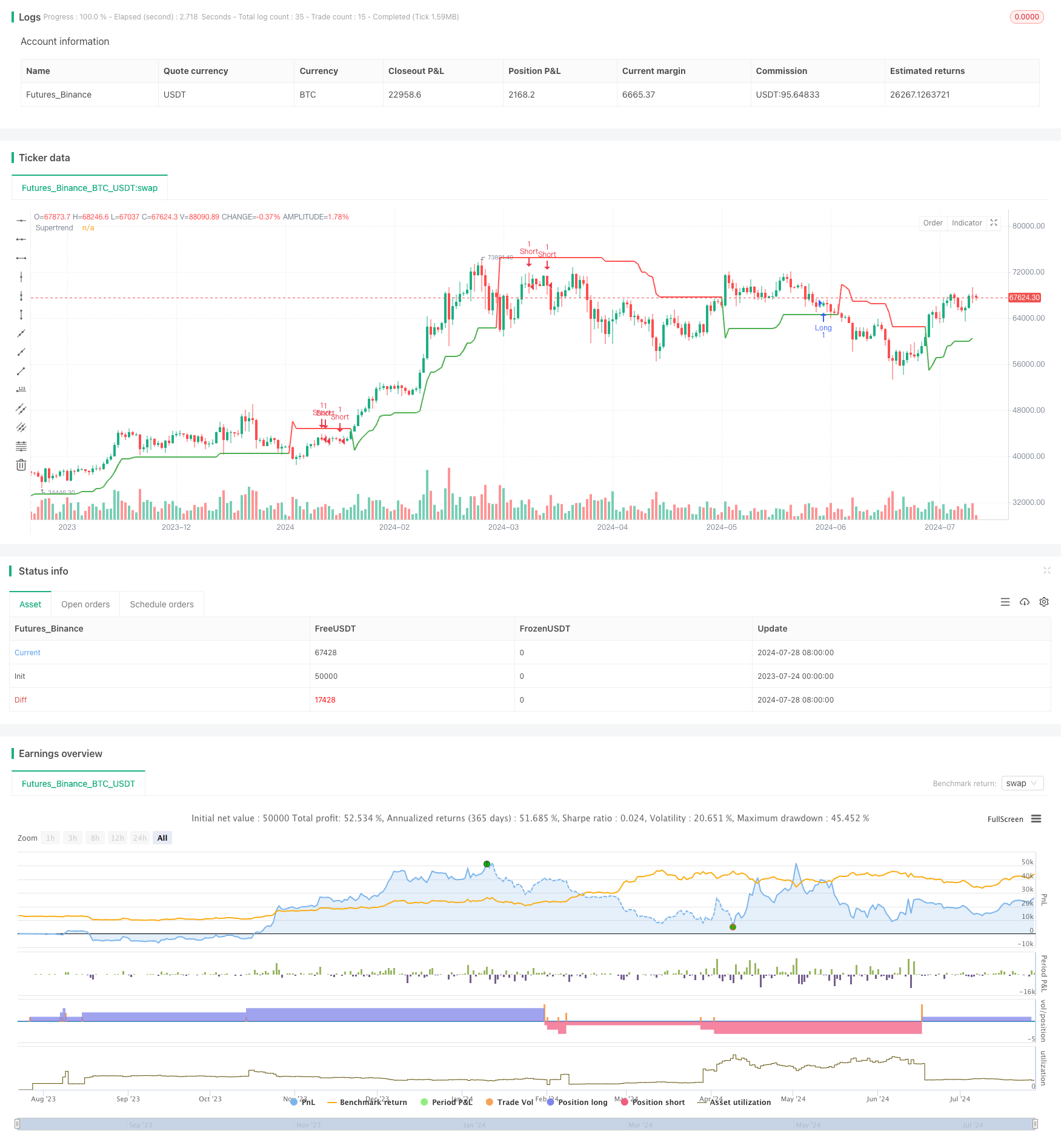
概述
这个策略是一个多重指标智能金字塔交易系统,综合运用了Supertrend、RSI和成交量等多个技术指标,通过金字塔加仓和1:2的止盈比例来优化交易效果。该策略主要通过Supertrend趋势判断、RSI超买超卖信号以及成交量变化来识别潜在的交易机会,同时利用金字塔式加仓来增加盈利潜力,并通过设置动态止损和1:2的止盈比例来控制风险。这种多维度的分析方法旨在提高交易的准确性和盈利能力,同时通过智能的仓位管理来优化整体交易表现。
策略原理
Supertrend指标:用于判断整体市场趋势,作为主要的交易信号生成器。
RSI指标:用于识别超买超卖状况,作为辅助交易信号。
成交量分析:通过对比当前成交量与前一期成交量,以及价格走势(看涨或看跌),来确认交易信号的强度。
入场条件:
- 多头:Supertrend方向向下(direction == -1),RSI低于超卖水平,出现看涨成交量(收盘价高于开盘价),且成交量大于前一期。
- 空头:Supertrend方向向上(direction == 1),RSI高于超买水平,出现看跌成交量(收盘价低于开盘价),且成交量大于前一期。
止损设置:使用Supertrend线作为动态止损点。
止盈策略:采用1:2的风险收益比,止盈点设置为入场点到止损点距离的两倍。
金字塔加仓:允许最多3次加仓(pyramiding=3),以在强劲趋势中获取更多利润。
策略优势
多维度分析:结合趋势、动量和成交量指标,提高交易信号的可靠性。
动态风险管理:使用Supertrend作为动态止损,随市场波动调整保护位。
优化的收益风险比:采用1:2的止盈比例,有利于长期盈利。
灵活的仓位管理:通过金字塔加仓,在强势行情中扩大盈利空间。
适应性强:可通过参数调整适应不同市场环境和交易品种。
全面的市场视角:通过综合分析趋势、超买超卖和成交量,全面把握市场动态。
策略风险
过度交易风险:多重指标可能导致频繁交易,增加交易成本。
假突破风险:在横盘市场中,可能出现频繁的假突破信号。
加仓风险:金字塔加仓在趋势反转时可能导致较大损失。
参数敏感性:多个指标参数需要精细调整,不当设置可能影响策略表现。
市场环境依赖:在低波动或趋势不明显的市场中可能表现欠佳。
滑点风险:频繁交易和止损止盈设置可能受到滑点影响。
策略优化方向
引入趋势强度过滤:可考虑加入ADX指标,只在趋势强劲时开仓,减少假突破。
优化加仓逻辑:设置动态的加仓条件,如要求每次加仓时RSI达到更极端值。
加入时间过滤:考虑市场时间特征,避开波动性较大的开盘和收盘时段。
引入波动率自适应:根据ATR动态调整止损和止盈幅度,适应不同波动环境。
优化成交量条件:考虑使用移动平均成交量作为参考,而非单纯的前一期对比。
加入市场regime识别:在不同市场状态(趋势、震荡)下使用不同的交易逻辑。
引入机器学习:使用机器学习算法动态优化指标参数,提高策略适应性。
总结
多重指标智能金字塔策略是一个综合性强、逻辑严密的交易系统。它通过结合Supertrend、RSI和成交量分析,全面评估市场状况,有效识别潜在的交易机会。策略的金字塔加仓机制和1:2的止盈比例设计,既增加了盈利潜力,又保证了合理的风险控制。虽然策略存在一定的风险,如过度交易和参数敏感性,但通过持续优化和风险管理措施,可以有效缓解这些问题。未来,通过引入更智能的过滤机制、动态参数调整和机器学习等技术,该策略有望进一步提升其适应性和盈利能力。总的来说,这是一个具有良好基础和广阔发展空间的量化交易策略,适合那些寻求在技术分析基础上构建复杂交易系统的交易者。
/*backtest
start: 2023-07-24 00:00:00
end: 2024-07-29 00:00:00
period: 1d
basePeriod: 1h
exchanges: [{"eid":"Futures_Binance","currency":"BTC_USDT"}]
*/
//@version=5
strategy("Supertrend RSI Volume Strategy with Pyramiding and 1:2 Take Profit", overlay=true, pyramiding=3)
// Supertrend Parameters
atrPeriod = input(10, title="ATR Period")
factor = input(3.0, title="Factor")
[supertrend, direction] = ta.supertrend(factor, atrPeriod)
// RSI Parameters
rsiPeriod = input(14, title="RSI Period")
overbought = input(50, title="RSI Overbought Level")
oversold = input(50, title="RSI Oversold Level")
rsi = ta.rsi(close, rsiPeriod)
// Volume Parameters
volumeGreaterThanPrevious = volume > volume[1]
bearishVolume = close < open
bullishVolume = close > open
// Entry Conditions
longCondition = direction == -1 and rsi < oversold and bullishVolume and volumeGreaterThanPrevious
shortCondition = direction == 1 and rsi > overbought and bearishVolume and volumeGreaterThanPrevious
// Calculate Stop Loss and Take Profit
longStopLoss = supertrend
shortStopLoss = supertrend
longTakeProfit = close + (close - longStopLoss)
shortTakeProfit = close - (shortStopLoss - close)
// Plotting Supertrend
plot(supertrend, color=color.new(direction == -1 ? color.green : color.red, 1), linewidth=2, title="Supertrend")
// Entry and Exit Signals with Pyramiding
if (longCondition)
strategy.entry("Long", strategy.long)
strategy.exit("Take Profit", "Long", limit=longTakeProfit, stop=longStopLoss)
if (shortCondition)
strategy.entry("Short", strategy.short)
strategy.exit("Take Profit", "Short", limit=shortTakeProfit, stop=shortStopLoss)